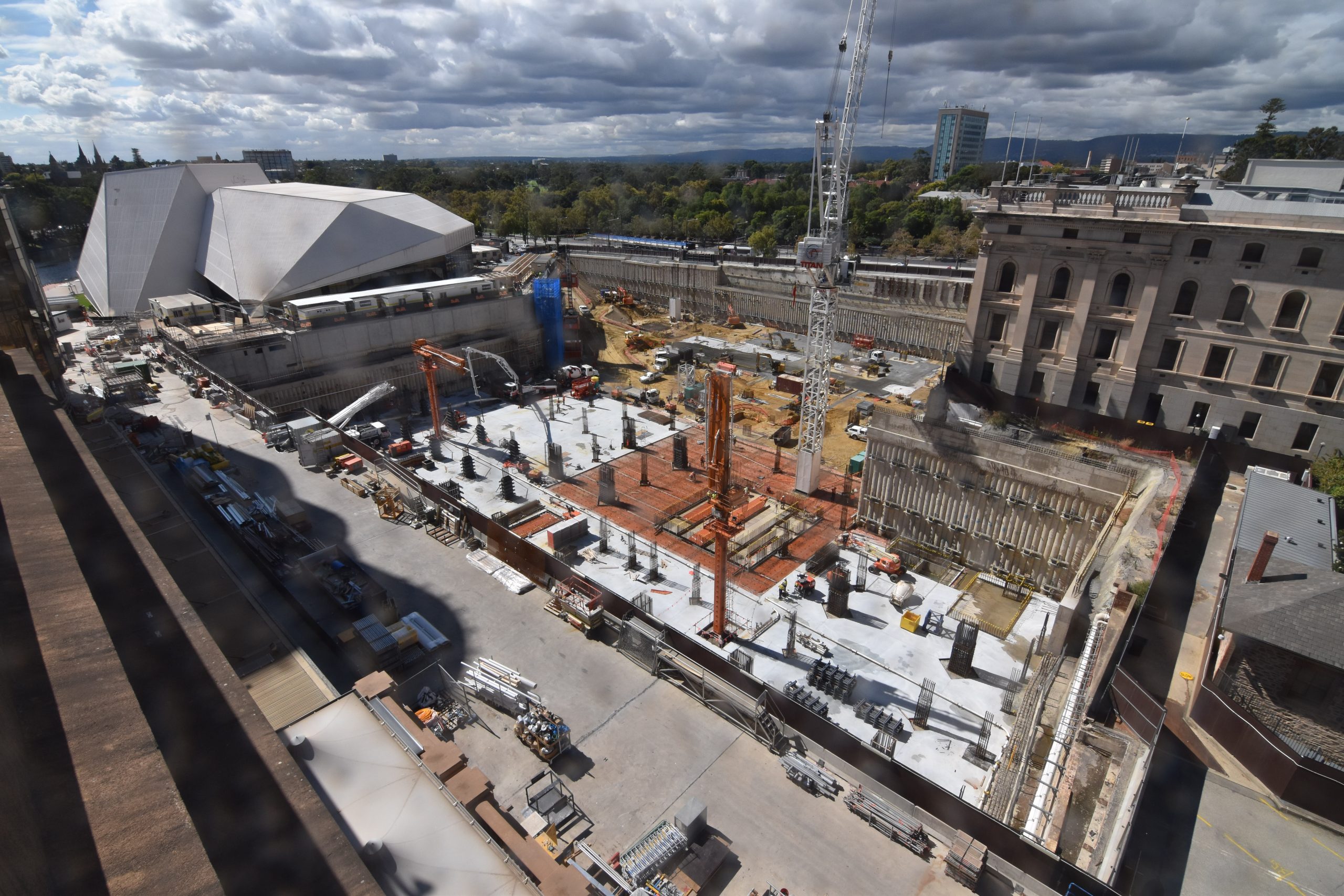How a run-down high-profile public space has transformed into a creative urban playground integrated with some of Adelaide’s most important building assets.
Not long ago, in the heart of Adelaide along the Riverbank, sat a large, dilapidated and underutilised space that people avoided walking through.
The block, built back in the 1970s, occupied prime real estate — sitting between Parliament House, the casino and the Adelaide Festival Center. But the existing carpark and plaza on the site were outdated and had fallen into disrepair.
Seeing an opportunity to revitalise the site over a decade ago, the State Government, in collaboration with developer Walker Corporation, commenced works on a masterplan for the site.
Mott MacDonald were engaged as the Civil and Structural Engineers for the Adelaide Festival Plaza Redevelopment project in 2014, which recently nabbed the Engineers Australia Project of the Year South Australia Excellence Award.
The scope of the work included a seamless public realm spanning 19,000 m2 and connecting six major buildings, along with a five-storey deep basement structure interfacing with existing public infrastructure on all sides.
Landscaping elements on the “lid” of the carpark seamlessly tie the major landmarks together with various planters, arbour structures and water features, said Samuel Daniels, senior structural engineer at Mott MacDonald.
“The introduction of large shade structures, seating, Indigenous artwork, trees and garden beds, and the capability to host major events, were all essential elements for the development and activation of the site,” he told create.
An accessible and sustainable design
Key to the design of the new plaza was embedding an ethos of accessibility and sustainability.
“From an accessibility point of view, all the pavement and the grading was fully Disability Discrimination Act-compliant to ensure inclusivity,” Daniels said.
To achieve sustainability goals, a structural build-up methodology was designed to reduce concrete levels wherever possible.
We used expanded polystyrene as a structural subgrade to build up the difference in elevation between the pavement grading and plaza base slab, which helped to minimise the overall plaza self-weight and total concrete volume – leading to a big reduction in embodied carbon,” he said.
With the basement structure sitting well below the water table, and requiring ongoing dewatering, water-sensitive urban design principles were used to ensure excessive nutrient levels in the groundwater could be treated prior to discharging back into stormwater and through to the River Torrens.
As part of an Environmental Protection Agency objective for groundwater management, Mott McDonald assisted in employing a solution to treat the intercepted groundwater prior to pumping it back into the natural stormwater.
“Rather than using mechanical treatment systems, we worked with the landscape architect to divert groundwater inflows into planter beds on the plaza,” Daniels said.
The biofiltration garden beds, complete with carefully selected flora such as reeds, naturally remove contaminants in the groundwater.
“This sustainable approach to managing and treating groundwater provides irrigation to the garden beds and is a good example of inner-city, water-sensitive urban design,” he added.
Bringing plant life back into an inner-city development was also a key objective of the project.
“Cities are primarily built up of concrete and bitumen,” Daniels said. “The new arbours and trees, once mature, will provide significant green coverage across the plaza and assist in managing the heat island effect that many inner-city public spaces suffer.”
Working closely with the project architects to ensure the planting depths and weights could be accommodated across the suspended slab was also essential to ensure this greenery objective.
An engineering feat
Achieving a new inner-city green public space among a diverse range of existing and new structures required an ambitious engineering approach. The team had to ensure the deep basement walls could support the adjoining structures while limiting the wall movements to extremely low values.
Due to the size of the plaza and basement floor plates, concrete shrinkage movements across its length would have exceeded acceptable wall movements, potentially damaging the surrounding heritage buildings.

“The technical viability of meeting these required limits was scrutinised heavily during this process,” Daniels said.
“We undertook extensive investigations onsite and thorough review of all available documentation to give us the best possible level of understanding of the constraints, along with robust sensitivity analysis to test the bounds of the structure behaviour.”
From there, an innovative joint system was designed to allow slab shrinkage to be dissipated over a two-year period, prior to load switching over from temporary wall anchors onto the plaza slab.
“The system of joints, and the slab system overall, performed exactly as intended and wall movements were kept within the strict limits mandated to protect the adjacent buildings, including Parliament House,” he said.
While there are still some construction works occurring on site, including the development of a 29-storey office tower also engineered by Mott MacDonald, the plaza is now a multidirectional thoroughfare linking the city centre.
“The space seamlessly connects the casino with the Festival Centre and Parliament House, along with the riverbanks through to North Terrace – one of the major roads of the city,” Daniels said.
“The project has transformed and reshaped one of Adelaide’s key precincts, turning it into a welcoming and functional space for the whole city.”
The national Excellence Awards are to be announced in Melbourne on 29 November. Register for the Gala event here.